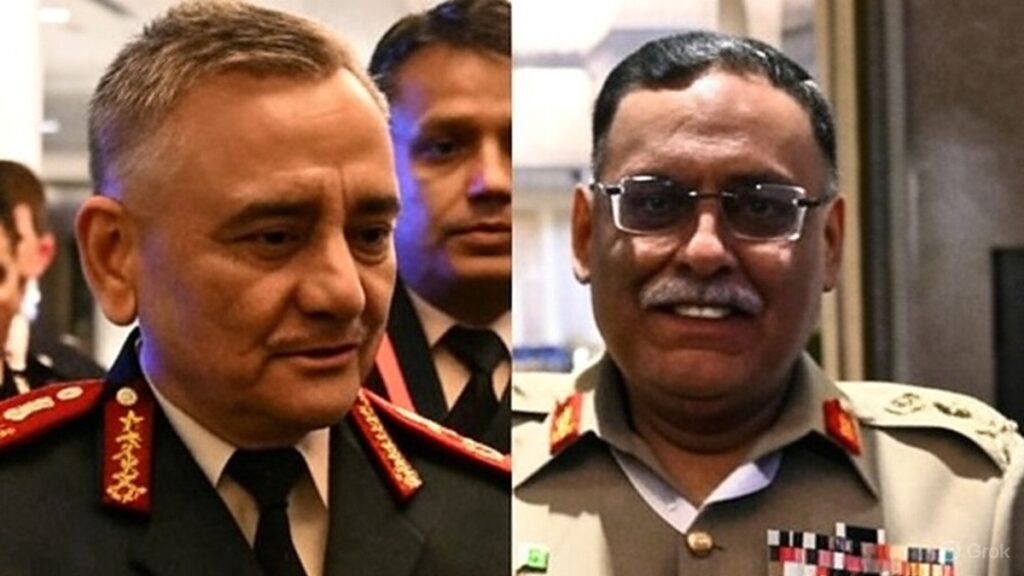CDS General Anil Chauhan cites a new “red line” on terror, while Pakistan’s General Sahir Shamshad Mirza warns of dangerous escalation amid the Kashmir dispute.
Singapore: At the 22nd Shangri-La Dialogue, held from May 30 to June 1, 2025, top military leaders from India and Pakistan—Chief of Defence Staff General Anil Chauhan and General Sahir Shamshad Mirza—exchanged sharp warnings, highlighting the deepening rift between the two nuclear-armed neighbors. The summit, a key platform for global defense discussions, saw both generals address the fallout from India’s Operation Sindoor and the broader implications for regional stability.
India’s New Red Line on Terror
General Anil Chauhan emphasized India’s redefined stance on terrorism, stating, “What India has done, politically, they have drawn a new red line of intolerance against terror.” Referring to Operation Sindoor, launched on May 7, 2025, to dismantle nine terror infrastructures in Pakistan and Pakistan-occupied Kashmir (PoK) following the April 22 Pahalgam attack that killed 26 civilians, Chauhan expressed hope that the operation would serve as a lesson for Pakistan. “I hope this particular operation, lying in the military domain, brings lessons for our adversary, showing the limit of India’s tolerance,” he added. The attack, the deadliest since the 26/11 Mumbai strikes, prompted India to adopt a multi-domain approach, integrating cyber, intelligence, and disinformation management, with 15% of efforts focused on countering fake narratives.
Pakistan’s Call for Conflict Resolution
General Sahir Shamshad Mirza, speaking on “Regional Crisis-Management Mechanisms,” urged a shift from conflict management to resolution, warning that the absence of the latter risks destructive escalation. He stressed the Kashmir issue as the core of India-Pakistan tensions, asserting, “An early resolution of Kashmir, in line with UN Security Council resolutions and the aspirations of its people, is essential for enduring peace.” Mirza cautioned that the recent military clash lowered the threshold of conventional warfare to “dangerous levels,” increasing risks across both nations. He also criticized India’s role as a “net security provider” backed by the West, claiming it discourages conflict management.
Operation Sindoor: A Strategic Shift
Operation Sindoor marked a significant escalation, with India targeting terror camps in retaliation for the Pahalgam attack. The four-day conflict, ending with a ceasefire on May 10 mediated by the US, UK, Turkiye, China, Saudi Arabia, and UAE, saw India employ French-made Rafale jets and Pakistan counter with Chinese J10-C fighters. General Chauhan revealed that India penetrated 300 km into Pakistan with precision strikes, despite initial losses on May 7, which were later rectified. He dismissed Pakistan’s claim of downing six Indian jets as “absolutely incorrect,” emphasizing rationality on both sides, stating, “There’s a lot of space for conventional operations before the nuclear threshold.” Posts on X reflect mixed sentiments, with some praising India’s firm stance, while others express concern over the lowered escalation threshold.
Global Implications and Kashmir Focus
The Shangri-La Dialogue underscored the fragile security dynamics in South Asia, with both generals highlighting their nations’ multi-sourced military capabilities—India’s diverse arsenal and Pakistan’s equipment from the US, Turkiye, and China. Mirza’s focus on Kashmir echoes Pakistan’s long-standing position, but India maintains that cross-border terrorism, not Kashmir, is the root issue, a stance reinforced by Shashi Tharoor’s recent comments in New York: “Pakistan stayed in denial, offering safe havens for terror.” The Stockholm International Peace Research Institute warns that the integration of AI, drones, and cyber tools in both nations’ arsenals heightens the risk of rapid escalation, especially without structured dialogue.
A Precarious Path Ahead
The exchange at Shangri-La signals a deepening divide, with India’s zero-tolerance policy clashing with Pakistan’s call for conflict resolution. The Center for Strategic and International Studies notes that the lack of crisis management mechanisms, as Mirza warned, could leave little time for global intervention in future conflicts. Despite the ceasefire, tensions remain high along the Line of Control, with India continuing Operation Sindoor’s defensive measures. As both nations modernize their militaries, the international community watches closely, fearing that the next spark could ignite a broader conflict in the region.


